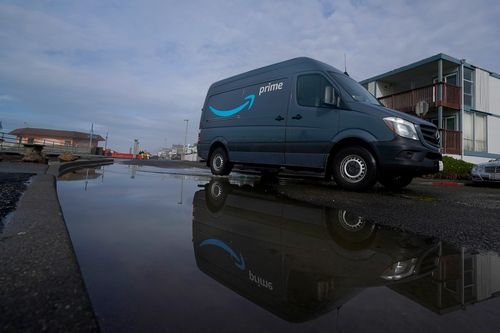Amazon is putting cameras in its delivery vans and some drivers aren’t happy

For Kamille Elizabeth, delivering Amazon packages in Wilmington, Delaware feels carefree and comfortable. She has deliveries to make and rules to follow, but says she enjoys being on the road by herself with what she calls a “limited freedom.”
But Elizabeth’s work environment is set to change as Amazon announced this month that it has begun to roll out cameras inside its delivery vehicles that monitor both the road, and its drivers.
Road safety experts say Amazon’s driver monitoring should bring safety benefits for the company and everyone it shares roads with. At the same time, drivers like Elizabeth are bracing themselves for what happens when cameras can scrutinize their every move, delivering feedback that could impact their livelihoods.
Amazon said in a recent video that it hopes the new system gives drivers “peace of mind” while delivering packages, but drivers like Elizabeth say they’re nervous.
“If one thing messes up, I’m going to freak out,” Elizabeth told CNN Business. “That’s my job, it’s over. They’re going to see it on camera.”
Amazon spokesperson Deborah Bass told CNN Business that drivers could not lose their jobs for a single mistake, but declined to detail how Amazon recommends the partner companies that make its deliveries handle feedback, coaching and discipline. Amazon has said video footage from the cameras will only be sent to it in certain circumstances, including hard braking, hard acceleration and U-turns.
“Safety is Amazon’s top priority,” Amazon’s Bass said in a statement. “Whether it’s state-of-the art telemetrics and advanced safety technology in last-mile vans, driver-safety training programs, or continuous improvements within our mapping and routing technology, we have invested tens of millions of dollars in safety mechanisms across our network, and regularly communicate safety best practices to drivers.”
Companies monitoring commercial drivers isn’t new. Businesses like UPS and DHL rely on telematics systems that track driver behavior such as seat belt use, speed, acceleration and braking. UPS says it’s relied on telematics for more than 20 years. Amazon is going further and embracing cameras consistently pointed at drivers, which rely on artificial intelligence to voice real-time feedback. Drivers will get real-time warnings if they run a stop sign, tailgate, or are distracted.
Amazon drivers say negative experiences with the company’s existing driver monitoring system contribute to their concerns.
Drivers already use an app called Mentor that scores driving by tracking braking, acceleration, cornering, speeding and distraction. But drivers interviewed by CNN Business say the app can unfairly penalize them as it misinterprets reasonable driving behaviors. Their smartphone falling on the floor, or sliding around their vehicle can be interpreted as hard cornering or harsh braking, they say. Receiving a text message can be considered distracted driving, they say, even if they don’t check their phone to read it. Mentor scores can impact a driver’s compensation.
The app has a 1.2 rating out of 5 on the Apple App Store, and a 1.3 out of 5 rating on the Google Play App Store. Many reviews of the app say that it causes fear, as the scoring can feel unpredictable.
“This app has given me nightmares!” said one reviewer on the Apple App Store.
Bass told CNN Business that Amazon works with vendors to continue to improve their products, but declined to comment on whether it is satisfied with the quality of the Mentor app, and if it feels the reviews reflect the quality of the app. Amazon also declined to share data on if its new camera monitoring system has been shown to improve safety.
But “the potential is huge,” said Matthew Camden, a researcher at the Virginia Tech Transportation Institute who has studied driver monitoring systems. Camden’s research has found that legacy driver monitoring systems reduced crashes by 38.1%. The addition of AI-powered abilities should add to the benefits he said, as real-time feedback can coach drivers to improve. Companies that offer AI-powered driver monitoring systems have reported collision reductions of more than 50%, but independent researchers haven’t yet studied the systems, according to Camden.
Elizabeth said there are some positives, such as drivers’ security and safety. She said she’s had colleagues who have been robbed, or had a gun pointed at them. (Amazon says in its video that drivers can upload footage in the case of someone approaching their vehicle.)
Juan Ramos, who delivers for Amazon in Garland, Texas, told CNN Business that he likes some of the cameras’ new safety features, such as tracking distracted driving, speeding and following distance. The cameras could clear drivers of trouble if they’re in a crash, he said. But he’s heard from drivers who think the cameras will micromanage them, and worry about getting in trouble or losing their jobs for what seems like a small infraction. He said he knows of drivers who have covered the cameras facing them, out of concern.
Victor Fuentes, an Amazon driver in California, has said on YouTube that he hates the cameras, as he sometimes needs to bend or break rules to get his work done quickly.
“In order for me to be fast, I gotta do some stuff that I should not do,” said Fuentes, who cited the example of often not wearing his seatbelt, but plugging it in behind him. He declined to comment on this story.
“If a driver needs to do a U-turn or needs to back up or do something to keep the deliveries going and they’re going to get scored or talked to about that, I feel like that’s not fair,” Ramos told CNN Business.
Still, Amazon may be on the frontier of a new trend.
The market for automated cameras is expected to triple over the next five to seven years, according to Jason Palmer, an executive at Omnitracs, which offers a driver monitoring system. Amazon relies on a system from Netradyne, which declined to comment for this story. Its competitors include Omnitracs, Lytx, Jungo and Samsara.
Amazon’s largest delivery competitors, UPS, FedEx and DHL all declined to say if they’ve considered using AI-powered driver monitoring systems. FedEx has worked with Lytx before, but declined to comment on the arrangement. UPS said it had briefly tested a camera unit, but hasn’t decided whether to adopt it.




